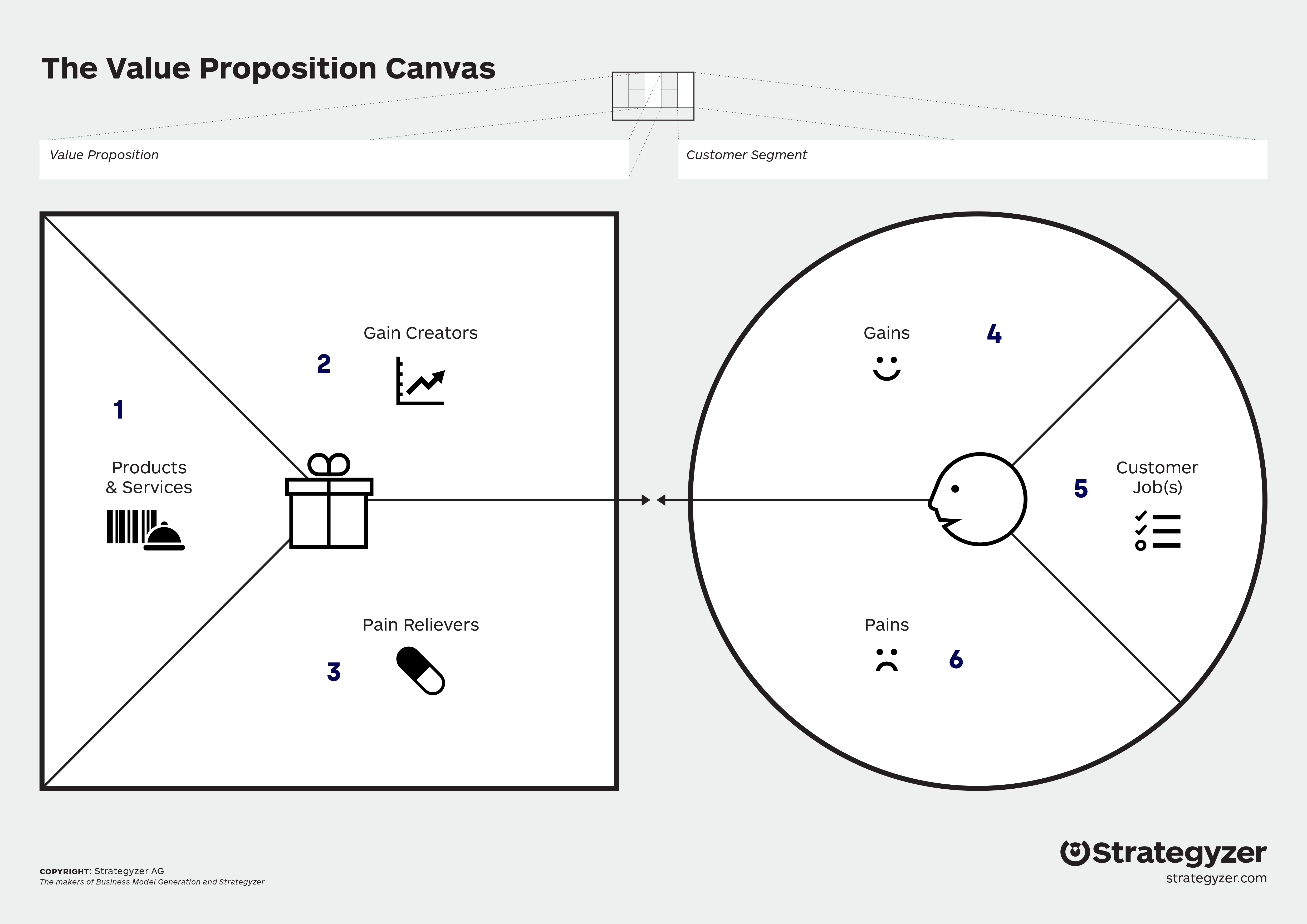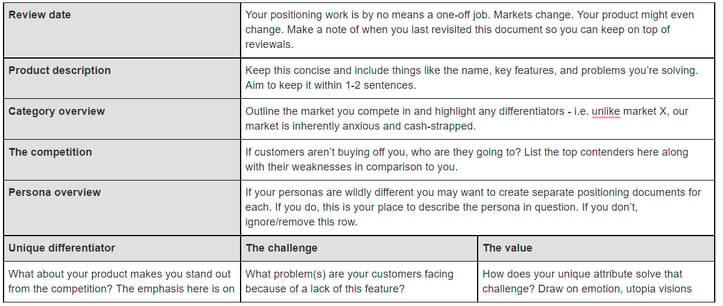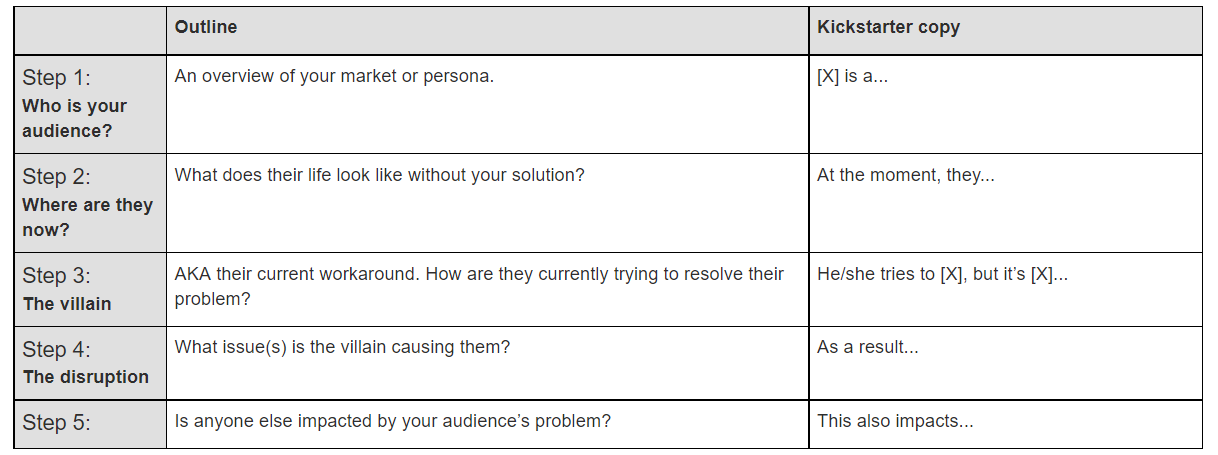This article has been written for SaaS product leaders involved in the go-to-market strategy and product-marketing initiatives. It’s been designed to give you the information that you need to build your SaaS positioning strategy framework.
The first step is to try to validate your value proposition. To do this, we suggest you use the value proposition template from Strategyzer as seen below.

Define your Value Proposition
You may or may not be familiar with this template; the value proposition canvas helps you map out how your product (or service) provides value to the potential customer.
To help us break this down, please note the numbers 1-6 added to the canvas so that we can explain the purpose of each section. On the left-hand side of the canvas, you will list where you discuss your product/service and the gains from its use or the pains it solves.
Value proposition
-
- Products & Services (1): This section identifies the product or service you are offering to your prospective customers.
- Gain Creators (2): In this section please list the benefits that your product or service offers your ideal customers.
- Pain Relievers (3): In this section list the pain relievers that product or service offers potential customers.
On the right-hand side of the canvas, you discuss the product from the perception of your customer segment or persona.
Customer segment
-
- Gains (4): List how your product or service provides gains for this customer segment.
- Customer jobs (5): List everything your potential customers have to do to feel the gains and relieve their pains.
- Pains (6): List all of your customer segment's pain points.
To best use the canvas, you should print it out on A0 (UK) paper or 841mm x 1189mm or 33.1in x 46.8in and pin it to the wall or draw it on a large whiteboard. Then use post-it notes to complete the sections and take photos of each outcome for records purposes.
Session tip
Start your session by working on the Customer Segment piece first, working on sections 5 and 4 then finishing on 6. Then move across and complete sections 1, and either of 2 or 3 depending on whether you intend to position on pains solved or gains created.
Characteristics of a great value proposition
As a rule of thumb, there are 10 characteristics of a great value proposition. These are:
-
- They are embedded in great business models
- Focus on a few pain relievers or value creators, but do so extremely well
- Focus on jobs, pains, or gains that a large number of customers have or for which a small number of customers are willing to pay a lot of money
- Align with how customers measure success
- Focus on the most significant jobs, most severe pain points, and most relevant gains
- Differentiate from the competition in a meaningful way
- Address functional, emotional, and social jobs all together
- Outperform competition substantially on at least one dimension
- Are difficult to copy
- Focus on unsatisfied jobs, pains, and gains
If you can ensure that your proposition meets all of these standards you can maximise the potential of your SaaS platform's positioning within the marketplace for increased deal flow. However, this isn’t the only thing that you need to ensure success for your SaaS business.
Now that you have established your value to the marketplace, you need to build a positioning framework that can be measured and incrementally improved over time. In the next part of this article, we discuss how you do this.
"Great positioning makes your strengths obvious. It provides context and a frame of reference, making it easy for customers to understand why they should care about what you do."
April Dunford, Positioning Maestro
Build a positioning framework
To successfully build a positioning framework, we assume that you have already worked out your customer segment or persona. If you haven’t, we suggest you first check out our persona eBook and run through the exercises within.
Firstly, you need to agree to the review date. Yes, before you get started you need to set a date that the document will be reviewed as over time your product, markets, or customer base may change.
Next, write up your product description. Keep this concise and include things like the name, key features, and problems you’re solving. Aim to keep it within 1-2 sentences.
Then describe your category; think of it as an overview of your product marketplace. Outline the market you compete in and highlight any differentiators - i.e., unlike market X, our market is inherently anxious and cash-strapped.
Following your category overview, describe the competition. If customers aren’t buying off you, who are they going to? List the top contenders here along with their weaknesses in comparison to you.
Once you have completed the above, describe your persona. If your personas are wildly different you may want to create separate positioning documents for each. If you do, this is your place to describe the persona in question.
To complete the framework, you need to define three more pieces of information. Create a spreadsheet (if you already haven’t) with three columns. Title them as follows; unique differentiator, the challenge, and the value. Then answer the following questions:
-
- Unique Differentiator: What about your product makes you stand out from the competition? The emphasis here is on the unique; if your competitor offers the exact same thing, it doesn’t belong here.
- The Challenge: What problem(s) are your customers facing because of a lack of this feature?
- The Value: How does your unique attribute solve that challenge? Draw on emotion, utopia visions and real-life quotes where possible.
List as many unique features as you can and then answer the challenge and value questions. Do this periodically and you will always be able to position your platform to its target market or target audience
Next, you need to design your storytelling framework. In the next section, we dive into this and explain how to create your story. SaaS companies build long-term foundations around product positioning by combining your positioning statement with a story.

Plan your position statement
There are six key components to drafting your positioning statement, but remember that your business may have a need for more than one position statement!
- Competitive alternatives - what customers would do if your solution didn't exist
- Unique attributes - the features and capabilities that you have the alternatives lack
- Value and proof - the benefits that those features enable for customers
- Target market characteristics - the characteristics of a group of buyers that really care a lot about the value you deliver
- Market category - the market you describe yourself as being part of so that customers understand your value proposition
- Relevant trends - trends that your customers understand and/or are interested in that can help make your product more relevant right now
Our advice is to make note of this, but complete the activities listed throughout this article and return with a clearer perspective on how you can best position your products and services.
Design your storytelling framework
Your storytelling framework has twelve key components. When done right, they inspire action, make you more memorable, unite your audience and simplify complex concepts.
But before you even think about putting pen to paper, you need to answer this question:
What are you trying to achieve?
And as you complete the steps below, keep the answer to the question top of your mind.
The twelve steps to a successful storytelling framework
Step 1: Who is your audience? Write an overview of your market or persona.
Step 2: Where are they now? Describe what their life looks like without your solution.
Step 3: The villain? AKA their current workaround. How are they currently trying to resolve their problem?
Step 4: The disruption? What issue(s) is the villain causing them?
Step 5: Which other characters are involved? Does your audience’s problem else impact anyone?
Step 6: How does it impact others? How are these other characters affected?
Step 7: The fairytale ending? What are your audience’s goals? And what is it they’re looking for in a vendor?
Step 8: The antagonist? Who’s getting in the way of their fairy tale ending? In the world of B2B, this might be the ‘blocker/gatekeeper’ stakeholder. In B2C, it could be cost.
Step 9: The hero? How does your solution replace the villain and appease the antagonist?
Step 10: What life could look like? Paint the picture of how much better life with your solution could be. What are the benefits? How will those benefits make them feel?
Step 11: The moral? What lessons can be learned from your customer’s journey?
Step 12: The new norm? End your story with real words, from real customers.
By closely following these twelve steps and answering the attached questions, you can create great market positioning for your customer experience whilst closely aligning your marketing and sales teams.
For best results, create a spreadsheet with the questions in bold in column A, the italic outline questions in column B, and in Column C add your Kickstarter copy. For an example see the image below.

So far so good. If you are still with us on this one, you are certainly putting in the effort to find the right position and story for your SaaS platform. However, to ensure that you capitalise on your work so far, you need to create an effective messaging framework.
In the next section, we discuss how you can build a messaging framework that will enable you to drive forward in your business niche and accelerate your sales conversations from your digital channels.
Build your messaging framework
Building your successful messaging framework is easy enough if you follow these key steps.
Value proposition
Your core value prop often appears on homepage headlines and is a clear, succinct statement of the unique value you offer customers. This should be closely tied to your positioning and have one, clear focal point. Length-wise, you’re looking at around 10-15 words.
Audience
Now focus on your audience. Write a brief background on the profile of the persona you’re targeting - note the emphasis on brief. Think about things like their personality, responsibilities, title, and role in the buying process. Remember, this is a person, not a company or group of people.
Elevator pitch
The next step of your messaging framework is your elevator pitch. Write 1 - 2 sentences that incorporate your value proposition.
What do you bring to the table that others don’t?
Make sure this is unique and captures emotions and the top one to two value points you deliver. If you can try, to squeeze a word or two in about who your target market is, too.
Long description
Focus on your long description. This should be no longer than 100-200 words. Again, this should include the value points uncovered in your positioning work, as well as:
-
- Product/feature details, headline benefits,
- An indication of your target market
- Proof points, too - i.e. names of current customers or anything brag-worthy (like awards, usage or satisfaction stats).
Tip #1: Keep It Super Simple (KISS). Avoid industry jargon and express your pitch as simply and purely as possible.
Tip #2: Run your pitch through the Readability and/or Hemingway apps to ensure they’re easily understood.
Tip #3: Focus on what you want the recipient to remember after seeing the elevator pitch — i.e. which outcomes and emotions should they have and feel.
Tone of voice
Now focus on your tone of voice. Is it:
-
- Formal?
- Conversational?
- Punchy?
- Friendly?
Your persona research should uncover this. This section should include 3-4 adjectives that describe your ideal voice and it’s also a good idea to include some before and after examples of what that voice sounds like so everyone on your team is super clear on what they’re aiming for.
Outcomes
After the tone of voice, your focus should switch to outcomes. What outcomes are possible because of your product/solution? List them as simple, concise bullet points.
Customer requirements
Then your customer requirements. What 1-2 things are crucial to your persona to convert? Keep this short and specific.
Outcome pillars
Last on your list are your outcome pillars. Choosing one word per pillar in 1-3 words should substantiate your elevator pitch and positioning work.
The sections of your outcome pillars should focus on these key areas:
-
- Pain points: What problem(s) does this value pillar solve?
- Product/feature benefits: How well does your product resolve those pain points? Stick to 3-5 bullet points and focus these around your value and supporting benefits
- Product/feature details: Which parts of your product are responsible for those benefits? And how do they make you unique? Ideally, these should align with your 3-5 bullets above
- Proof points: Back up what you’re saying with a snapshot of a real-life case study. For example, “Within eight weeks of onboarding, John from Pretend PLC saved 10+ hours a month and increased his MRR by 11%.” If your personas have different pain points and requirements, you should have different proof points
By following these clear guidelines and adopting a practice of learning, apply and repeat, you can set your SaaS platform up for success. And by combining your value proposition with the other three frameworks and doing it well, the team here at BIAS believes you will move from strength to strength.
The real problem for fast growth SaaS organisations is that often the teams change at speed and the process is what suffers for that. It's simply irresponsible to throw out process or measurement capabilities for growth so that you can fix them later.
We live in a world of data and data-driven decision-making, so why would you object to using a complete positioning strategy when it directly impacts the bottom line and the firm's ability to generate revenue?
If your team needs any assistance with their positioning strategy, please do not hesitate to reach out and talk to a team member. Our ARISE© product builds on this work to ensure your entire go-to-market strategy is fit for purpose and creates a solid foundation for growth.

%20small.jpg)


